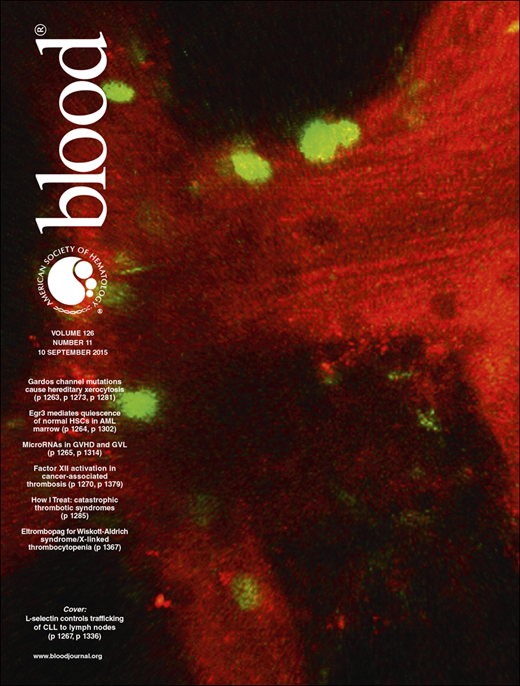A 38-year-old man was admitted because of cough, fever, headache, and malaise. He was pale but otherwise in good general condition. The hemogram showed: white blood cell count, 1.7 × 109/L; hemoglobin, 97 g/L (mean corpuscular volume, 99 fL); and platelets, 7 × 109/L. A blood smear showed marked anisocytosis, anisochromia, and poikilocytosis; no blast cells were observed. A bone marrow aspirate showed 82% erythroblasts and marked dyserythropoietic signs (panels A-B) including extraordinarily giant polychromatophilic red blood cells with prominent basophilic stippling (panel C, red arrow). In addition, 12% blasts (myeloperoxidase positive; black arrow) were counted. The karyotype was 46 XY, −7, +21 [14]/46 XY [6]. A diagnosis of acute erythroid leukemia (AEL) erythroid/myeloid or French-American-British M6 acute myeloid leukemia was achieved. The patient entered complete remission after a 3+7 idarubicin–Ara-C regimen and is currently scheduled for a matched unrelated donor bone marrow transplantation.
In their later differentiating stages in bone marrow, erythroblasts undergo a decrease in cell size, nuclear extrusion, and internal organelle degradation before traversing the sinus endothelium. In the setting of the continuum of myelodysplastic syndrome/AEL, marked abnormalities of erythroid maturation in the bone marrow niche occur as seen in the 3 panels. We herein show an extreme example of asynchronism between enucleation and cell size reduction.
A 38-year-old man was admitted because of cough, fever, headache, and malaise. He was pale but otherwise in good general condition. The hemogram showed: white blood cell count, 1.7 × 109/L; hemoglobin, 97 g/L (mean corpuscular volume, 99 fL); and platelets, 7 × 109/L. A blood smear showed marked anisocytosis, anisochromia, and poikilocytosis; no blast cells were observed. A bone marrow aspirate showed 82% erythroblasts and marked dyserythropoietic signs (panels A-B) including extraordinarily giant polychromatophilic red blood cells with prominent basophilic stippling (panel C, red arrow). In addition, 12% blasts (myeloperoxidase positive; black arrow) were counted. The karyotype was 46 XY, −7, +21 [14]/46 XY [6]. A diagnosis of acute erythroid leukemia (AEL) erythroid/myeloid or French-American-British M6 acute myeloid leukemia was achieved. The patient entered complete remission after a 3+7 idarubicin–Ara-C regimen and is currently scheduled for a matched unrelated donor bone marrow transplantation.
In their later differentiating stages in bone marrow, erythroblasts undergo a decrease in cell size, nuclear extrusion, and internal organelle degradation before traversing the sinus endothelium. In the setting of the continuum of myelodysplastic syndrome/AEL, marked abnormalities of erythroid maturation in the bone marrow niche occur as seen in the 3 panels. We herein show an extreme example of asynchronism between enucleation and cell size reduction.
For additional images, visit the ASH IMAGE BANK, a reference and teaching tool that is continually updated with new atlas and case study images. For more information visit http://imagebank.hematology.org.

![A 38-year-old man was admitted because of cough, fever, headache, and malaise. He was pale but otherwise in good general condition. The hemogram showed: white blood cell count, 1.7 × 109/L; hemoglobin, 97 g/L (mean corpuscular volume, 99 fL); and platelets, 7 × 109/L. A blood smear showed marked anisocytosis, anisochromia, and poikilocytosis; no blast cells were observed. A bone marrow aspirate showed 82% erythroblasts and marked dyserythropoietic signs (panels A-B) including extraordinarily giant polychromatophilic red blood cells with prominent basophilic stippling (panel C, red arrow). In addition, 12% blasts (myeloperoxidase positive; black arrow) were counted. The karyotype was 46 XY, −7, +21 [14]/46 XY [6]. A diagnosis of acute erythroid leukemia (AEL) erythroid/myeloid or French-American-British M6 acute myeloid leukemia was achieved. The patient entered complete remission after a 3+7 idarubicin–Ara-C regimen and is currently scheduled for a matched unrelated donor bone marrow transplantation. / In their later differentiating stages in bone marrow, erythroblasts undergo a decrease in cell size, nuclear extrusion, and internal organelle degradation before traversing the sinus endothelium. In the setting of the continuum of myelodysplastic syndrome/AEL, marked abnormalities of erythroid maturation in the bone marrow niche occur as seen in the 3 panels. We herein show an extreme example of asynchronism between enucleation and cell size reduction.](https://ash.silverchair-cdn.com/ash/content_public/journal/blood/126/11/10.1182_blood-2015-06-651646/4/m_1391f1.jpeg?Expires=1763670244&Signature=Nva7eMI7dqahaGuwO10T55Z730iSDykRMIySlMtQPmqyLjAWjtuGySfW4GDGxGxAftW7T2qaPc0m85LvTTxsb60iGiZ2lkDibMXSsVmS-tx2vScUk7D3PSfcPG2ECkhWm9b2EEypr15ZCjdFJmYSfiHFiG6bv4lPVaAaioOH9ijsi97wIm-VGhBITFwsG5tKX-KsGP20QHPFVqZqZHnYfk4DqZ3wzar5GHqla6lgVsqT7-H5Bp-R-vchfIaEAwcH9wJ~l2kHWfVFbyv65MpZOlTpxR3PhV0rIa-1wJZ81s4z3dday-QAZ-llKiI-lY1V9cDh6jT4KQ4Sb~awdxa5tQ__&Key-Pair-Id=APKAIE5G5CRDK6RD3PGA)

![A 38-year-old man was admitted because of cough, fever, headache, and malaise. He was pale but otherwise in good general condition. The hemogram showed: white blood cell count, 1.7 × 109/L; hemoglobin, 97 g/L (mean corpuscular volume, 99 fL); and platelets, 7 × 109/L. A blood smear showed marked anisocytosis, anisochromia, and poikilocytosis; no blast cells were observed. A bone marrow aspirate showed 82% erythroblasts and marked dyserythropoietic signs (panels A-B) including extraordinarily giant polychromatophilic red blood cells with prominent basophilic stippling (panel C, red arrow). In addition, 12% blasts (myeloperoxidase positive; black arrow) were counted. The karyotype was 46 XY, −7, +21 [14]/46 XY [6]. A diagnosis of acute erythroid leukemia (AEL) erythroid/myeloid or French-American-British M6 acute myeloid leukemia was achieved. The patient entered complete remission after a 3+7 idarubicin–Ara-C regimen and is currently scheduled for a matched unrelated donor bone marrow transplantation. / In their later differentiating stages in bone marrow, erythroblasts undergo a decrease in cell size, nuclear extrusion, and internal organelle degradation before traversing the sinus endothelium. In the setting of the continuum of myelodysplastic syndrome/AEL, marked abnormalities of erythroid maturation in the bone marrow niche occur as seen in the 3 panels. We herein show an extreme example of asynchronism between enucleation and cell size reduction.](https://ash.silverchair-cdn.com/ash/content_public/journal/blood/126/11/10.1182_blood-2015-06-651646/4/m_1391f1.jpeg?Expires=1763670245&Signature=QnA7QSoio7-pKw-GErBXF71epmedZqqPcAWMxHjoDWQ9sS6auR9AyUa9v6Nz~r4QlZ92Up0qV-icsW6lwIGV7p0PCrmvx3EC8l~8JDL~EO4j6wUEZ4xM13oOb5O1DR11JmN~9RyH6hbpNXs0-j75GMP9ateYFqxvkWjmNWZbH6Ct7z0jV-QoG0KtZ4UXK~CPfGajKDdRmNT7AiVFb5ZYw50~Nl~1qGAXnDQuuNawf-ZGxMrI9KxbONOYWDa9IDoIjmblFuApakJHDvQr-M5-08Ij1ycQ0f4Bzv-80Ivq4ne~CbRHOlJ6kfNFiAfVZtTpCwW32awgqxvGfvAGWW6~yw__&Key-Pair-Id=APKAIE5G5CRDK6RD3PGA)